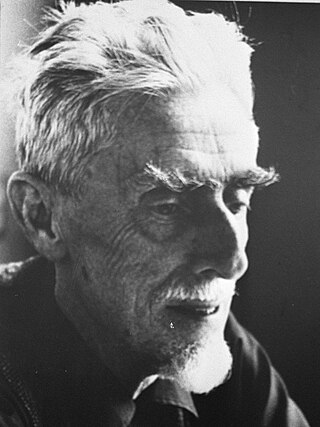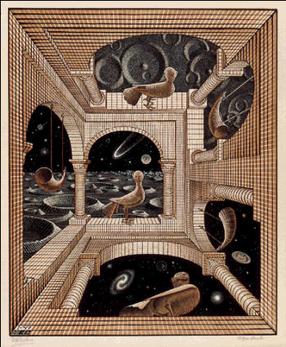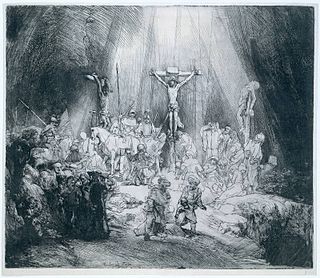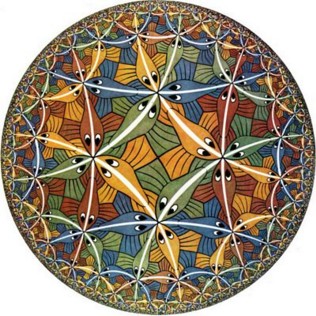Related Research Articles

Maurits Cornelis Escher was a Dutch graphic artist who made woodcuts, lithographs, and mezzotints, many of which were inspired by mathematics. Despite wide popular interest, for most of his life Escher was neglected in the art world, even in his native Netherlands. He was 70 before a retrospective exhibition was held. In the late twentieth century, he became more widely appreciated, and in the twenty-first century he has been celebrated in exhibitions around the world.

Katsushika Hokusai, known simply as Hokusai, was a Japanese ukiyo-e artist of the Edo period, active as a painter and printmaker. He is best known for the woodblock print series Thirty-Six Views of Mount Fuji, which includes the iconic print The Great Wave off Kanagawa. Hokusai was instrumental in developing ukiyo-e from a style of portraiture largely focused on courtesans and actors into a much broader style of art that focused on landscapes, plants, and animals. His works are thought to have had a significant influence on Vincent van Gogh and Claude Monet during the wave of Japonisme that spread across Europe in the late 19th century.

An impossible object is a type of optical illusion that consists of a two-dimensional figure which is instantly and naturally understood as representing a projection of a three-dimensional object but cannot exist as a solid object. Impossible objects are of interest to psychologists, mathematicians and artists without falling entirely into any one discipline.

Woodcut is a relief printing technique in printmaking. An artist carves an image into the surface of a block of wood—typically with gouges—leaving the printing parts level with the surface while removing the non-printing parts. Areas that the artist cuts away carry no ink, while characters or images at surface level carry the ink to produce the print. The block is cut along the wood grain. The surface is covered with ink by rolling over the surface with an ink-covered roller (brayer), leaving ink upon the flat surface but not in the non-printing areas.

Thomas Bewick was an English wood-engraver and natural history author. Early in his career he took on all kinds of work such as engraving cutlery, making the wood blocks for advertisements, and illustrating children's books. He gradually turned to illustrating, writing and publishing his own books, gaining an adult audience for the fine illustrations in A History of Quadrupeds.
Color printing or colour printing is the reproduction of an image or text in color.

Metamorphosis II is a woodcut print by the Dutch artist M. C. Escher. It was created between November, 1939 and March, 1940. The print measures 19.2 by 389.5 centimetres and was printed from 20 blocks on 3 combined sheets. Metamorphosis II is a long, horizontal piece which depicts animals and other forms gradually transforming into each other.

Another World II, also known as Other World II, is a woodcut print by the Dutch artist M. C. Escher first printed in January 1947.

Metamorphosis III is a woodcut print by the Dutch artist M. C. Escher created during 1967 and 1968. Measuring 19 cm × 680 cm, this is Escher's largest print. It was printed on thirty-three blocks on six combined sheets.

Wood engraving is a printmaking technique, in which an artist works an image into a block of wood. Functionally a variety of woodcut, it uses relief printing, where the artist applies ink to the face of the block and prints using relatively low pressure. By contrast, ordinary engraving, like etching, uses a metal plate for the matrix, and is printed by the intaglio method, where the ink fills the valleys, the removed areas. As a result, the blocks for wood engravings deteriorate less quickly than the copper plates of engravings, and have a distinctive white-on-black character.

Stars is a wood engraving print created by the Dutch artist M. C. Escher in 1948, depicting two chameleons in a polyhedral cage floating through space.

The hamsa is an aquatic migratory bird, referred to in ancient Sanskrit texts which various scholars have interpreted as being based on the goose, the swan, or even the flamingo. Its image is used in Indian and Southeast Asian culture as a spiritual symbol and a decorative element. It is also used in a metaphorical sense with the bird attributed with the mythical ability to extract milk from a mixture of milk and water or good from evil. In Hindu iconography, hamsa is the vahana of Brahma, Gayatri, Saraswati, and Vishvakarma.

Shikō Munakata was a woodblock printmaker active in Shōwa period Japan. He is associated with the sōsaku-hanga movement and the mingei movement. Munakata was awarded the "Prize of Excellence" at the Second International Print Exhibition in Lugano, Switzerland in 1952, and first prize at the São Paulo Bienal Exhibition in Brazil in 1955, followed by Grand Prix at the Venice Biennale in 1956, and the Order of Culture, the highest honor in the arts by the Japanese government in 1970.
Earl Marshawn Washington is an American entrepreneur, printmaker, and engraver.

An old master print is a work of art produced by a printing process within the Western tradition. The term remains current in the art trade, and there is no easy alternative in English to distinguish the works of "fine art" produced in printmaking from the vast range of decorative, utilitarian and popular prints that grew rapidly alongside the artistic print from the 15th century onwards. Fifteenth-century prints are sufficiently rare that they are classed as old master prints even if they are of crude or merely workmanlike artistic quality. A date of about 1830 is usually taken as marking the end of the period whose prints are covered by this term.

Metalcut was a relief printmaking technique, belonging to the category of old master prints. It was almost entirely restricted to the period from about 1450 to 1540, and mostly to the region around the Rhine in Northern Europe, the Low Countries, Germany, France and Switzerland; the technique perhaps originated in the area around Cologne.

István Orosz is a Hungarian painter, printmaker, graphic designer and animated film director. He is known for his mathematically inspired works, impossible objects, optical illusions, double-meaning images and anamorphoses. The geometric art of István Orosz, with forced perspectives and optical illusions, has been compared to works by M. C. Escher.

Mathematics and art are related in a variety of ways. Mathematics has itself been described as an art motivated by beauty. Mathematics can be discerned in arts such as music, dance, painting, architecture, sculpture, and textiles. This article focuses, however, on mathematics in the visual arts.

The wordless novel is a narrative genre that uses sequences of captionless pictures to tell a story. As artists have often made such books using woodcut and other relief printing techniques, the terms woodcut novel or novel in woodcuts are also used. The genre flourished primarily in the 1920s and 1930s and was most popular in Germany.

Circle Limit III is a woodcut made in 1959 by Dutch artist M. C. Escher, in which "strings of fish shoot up like rockets from infinitely far away" and then "fall back again whence they came".
References
- 1 2 Hofstadter, Douglas (1979). Gödel, Escher, Bach. Basic Books. p. 252. ISBN 978-0-465-02656-2.
- 1 2 "Day and Night". In Het Paleis. Retrieved 18 August 2022.
- ↑ "Prints & Multiples / Maurits Cornelis Escher (1898-1972); Day and Night (Blue Variant);". Bonhams. 29 March 2022. Retrieved 18 August 2022.
- ↑ Lawson, Sarah (November 2015). "The paradoxical universe of M.C. Escher". Cassone: The International Online Magazine of Art and Art Books. Retrieved 18 August 2022.